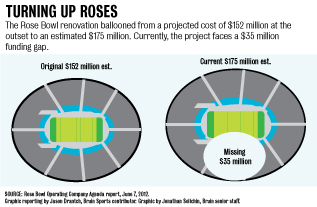With UCLA football’s home opener less than two months away, the Rose Bowl renovation project continues to move toward its 2014 completion.
The project is currently in the midst of phase two, with the final phase set to begin after the 2013 Rose Bowl game.
These phases consist of widening the four tunnels on the north and south sides of the stadium, the demolition of the press box and construction of a new stadium pavilion structure on the west side. Additionally, a new video board will be placed on the north end along with a restored scoreboard on the south end.
Despite there being much construction left to be completed, the Rose Bowl is expected to be fit to host the Bruins come September.
“We’re going to be ready for the upcoming UCLA season opener, September 8, against Nebraska,” said Darryl Dunn, Rose Bowl Operating Company general manager.
Renovation construction will be ongoing during the football season but will not prevent the games from being held at the Rose Bowl.
“(The workers) stop construction during the weekends when events are going on,” said Bill Cormier, UCLA representative to the RBOC. “They secure the construction sites so there are no safety issues.”
Although construction won’t interfere with football season, funding has recently become an issue, as the cost of the renovation has turned out to be greater than was expected when the project began.
When the project was approved in October 2010, the estimated cost was $152 million, but is currently estimated to be $175 million. Along with a $12 million funding gap at the outset of the project, the new estimation has left the RBOC with an estimated $35 million funding gap that must be closed in order for the renovations to be completed.
UCLA’s recent 30-year lease agreement with the RBOC calls for the university to provide a negotiated contribution toward stadium improvements. UCLA’s contribution is based on a percentage agreed upon in the lease, so rising costs have increased the amount the university needs to provide.
“UCLA has a significant stake in this, but it’s not like there’s a specific amount they have put on the table,” Cormier said.
In order to accomplish closing the funding gap, a nonprofit organization called Legacy Connections has been established, which started the Rose Bowl Legacy Campaign to raise funds from private donors.
“Their purpose is to help close the funding gap and to help make the Rose Bowl a better stadium for our fans and (so) the public can enjoy it for the future,” Dunn said. “We are supporting (the nonprofit organization) in all the ways we can and the more successful they are, the better a stadium the Rose Bowl is going to be.”
The organization has raised $8 million of its $20-25 million goal as of this week.
There are several other options that the RBOC has at its disposal in order to close the gap. These alternatives include refinancing an existing debt to raise revenue, deferring certain project elements until a later date, and reducing the scope of the project.
Victor Gordo, president of the RBOC, said a decision on which route to take in closing the funding gap is under review by all parties involved and will likely be made soon.
“We hope that the board will have for consideration in the next week or so a recommendation that has the consensus of both the tenants and the city of Pasadena,” Gordo said.
The RBOC is meeting twice within the next week in order to hear the input of UCLA and the Tournament of Roses as they weigh their options to craft the final plan for moving forward with the project.
“We are still working with the Tournament of Roses and UCLA to develop a consensus on what will be done in phase three and potentially what elements of the project may be deferred,” Dunn said.
No matter what decision the RBOC makes, the construction will not interfere with the Bruins’ first season under new coach Jim Mora.
“It won’t affect UCLA’s chances on the field, that’s up to the coaching staff,” Cormier said.
